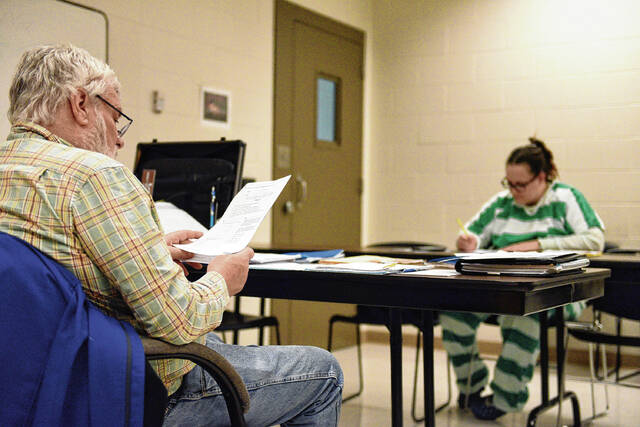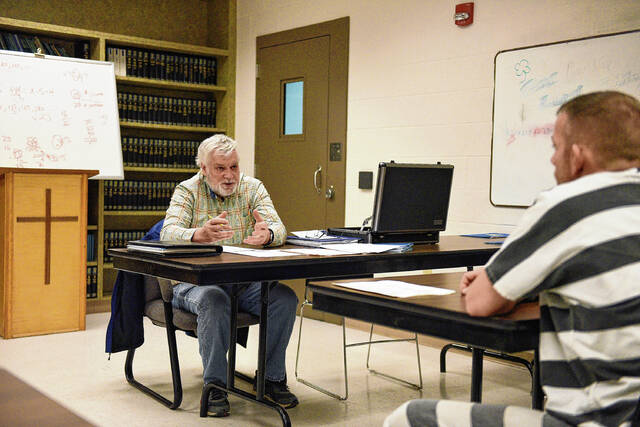How can a safety net be built to help inmates not end up back in jail after their release? How can the community wrap its arms around its youngest residents who have experienced trauma in their lives?
Those questions and more are what the Brown County Recovery and Wellness Coalition, in partnership with local mental healthcare provider Centerstone, intend to answer after recently applying for more than $700,000 in federal grant funding. The proposed grant-funded initiatives have received support from local government, law enforcement and nonprofits.
Funding from both grants would expand services in the Brown County jail to help inmates prepare for their release, making sure they were connected to all the services available to help them. One grant will go towards an initiative that will use the results of a quiz that scores traumatic experiences in a child’s life to better predict any future stressors or obstacles they may encounter.
Brown County Community Corrections Executive Director Joshua Bales first introduced the grants at the Feb. 16 Brown County Commissioners meeting. He requested a letter of support from the commissioners along with $20,000 in match money for the approximately $650,000 in funding requested from the Community Catalyst grant program. Bales is also vice president of the recovery and wellness coalition.
The Indiana Family and Social Services Administration Division of Mental Health and Addiction is administering the Community Catalyst grant. It is a onetime funding opportunity to address mental health needs throughout the state.
Funding would be used to create the Brown County ACEs Initiative. The 10-question Adverse Childhood Experiences, or ACEs, quiz is designed to be given to children before their 18th birthday.
Questions center on such topics as whether the child was abused physically, emotionally or sexually; if their parents divorced; if a household member had gone to prison; if the child felt like a parent was ever too drunk or high to take care of them; and if they felt like they were loved and taken care of.
Each ‘Yes’ answer is one point. The higher the ACE score, the more likely a child is to experience challenges such as chronic disease and risky behavior, like drug use, in the future, according to the Centers for Disease Control.
The grant-funded ACEs initiative locally would create multiple positions and programs to address these traumatic experiences and help children with high ACEs scores.
On March 2, the recovery and wellness coalition was awarded a separate $84,000 Community Coordination grant. That grant is also administered through the FSSA Division of Mental Health and the state’s Addiction and Forensic Treatment Team. That grant money will be given to the Brown County Sheriff’s Department to create a jail services coordinator.
This person will be employed through the sheriff’s department and would be responsible for connecting inmates with services in the community as well as help connect their families to resources.
The purpose of the Community Coordination grant “is to allow counties to develop, improve, coordinate, align and enhance county coordination related to access to treatment for substance use disorder and mental health,” Bales said.
The grant will run from March 1 this year to Feb. 28, 2023. The hope is that future grant funding can be secured to further fund this position.
The Community Catalyst grant awards are expected to be made in May with grants taking effect in July.
Overcoming barriers
After hearing the idea, Sheriff Scott Southerland immediately supported creating a jail services coordinator position in his department.
“There are so many opportunities slipping through the cracks. We can do more to connect these people with services once they leave,” he said.
”I think that (when they leave) is the most critical time. I promise you they are sober when they leave here. It’s when they leave, the first few days I think are probably most critical. If we can get them down the right path after they walk out the door I think it will increase their chances of success.”
Less people being arrested means less crime in the county, which is ultimately the goal for law enforcement.
Southerland said a high percentage of inmates are in the jail on charges either directly or indirectly related to substance use disorder. Some inmates have other mental health issues that could benefit from additional services while they are incarcerated and when they are released.
Many resources and services exist in the county to help those with mental health issues or who are battling substance use disorder, but help is needed to make that connection for inmates and their families. That is where the jail services coordinator will come in.
Both the commissioners and county council expressed their support for this new position, along with the proposed ACEs initiative, at their meetings last month. The jail services coordinator will be trained as a corrections officer and will report to the jail commander.
The new coordinator would help schedule peer recovery, religious-based, high school equivalency and religious-based services for inmates. The goal is the inmates will have the tools they need to have success after being released, ultimately reducing recidivism.
“The hope is to take the burden off of the jailers so they can be correctional officers and focus on the safety and well being of the inmates and allow us to bring in more services and overcome some of the barriers that exist to doing that right now,” Bales said.
The new coordinator will be trained in mental health and substance use disorder-specific training as well as trauma informed care and ACEs.
Community Coordination grant funding will cover the salary, benefits, equipment and training for the new employee. The county council voted in favor of allowing the coalition to proceed on the grant timeline Feb. 21 and that they once it is received they would vote on the job description to add the new position into the salary ordinance. Even though the position is grant-funded it still needs to be in the county’s salary ordinance due to the coordinator being an employee through the sheriff’s department. If future grant opportunities are not secured for this new position, the county will be asked to continue funding if it is deemed successful.
Coalition member Melissa Rittenhouse attended the county council meeting along with Dr. Sandy Washburn, who works with Brown County Schools on social/emotional learning curriculum, to request the coordinator position be added to the salary ordinance.
“We’re hoping it will show savings in other ways. We’re hoping it reduces recidivism from individuals who were not receiving these treatments, so they were basically being released back with the same conditions they went into, which brings more and more arrests,” Rittenhouse said during the county council meeting last month.
Along with supervising service visits and meetings, the new coordinator will also be expected to meet with community partners to better understand all services available to inmates and their families.
“It’s making sure that the individual is connected at a time that works and when their service provider comes they have supervision for their safety. It’s not just making connections to get the services in the jail,” Rittenhouse said.
“Those connections are kind of already there, the barrier is we don’t have someone who has the ability to take the time and make the schedules, answer the phone calls, prepare the room for the service times.”
According to the proposed grant timeline the new employee will begin in June and will start screening inmates for services by July.
“Even when an inmate is in there for a day or two if we can plug them into services that will help them better their ability to be a member of our society,” Rittenhouse said.
“That is going to benefit their children, their spouses, their employers. It’s going to help ripple out from just thinking about an inmate.”
Whole picture
Results from a recent Indiana Youth Survey indicates that 16.7% of Brown County children age 15 and 21.6% of local 16 year olds are at-risk for having a substance use disorder.
The survey data also shows the percentage of children in ninth through 12th grade have considered attempting or have attempted suicide at a higher rate than the state and country.
The 2020 Youth Survey results also showed that the rate of parental incarceration for sixth-grade students was almost two times as great as the state’s rate, Bales shared with commissioners last month.
He explained that other data shows that youth in Brown County do not have as many “protective factors,” like social connections, to combat problematic behaviors brought about by experiencing trauma at a young age, like a parent being arrested.
“That is how the cycle begins. If I arrest mom or dad who is coming to the child to talk about how that is affecting them?” said Rittenhouse, who previously worked as a police officer.
The ACEs quiz is a “predictor,” Bales explained.
“People with certain scores and higher are more likely to have risk of injury, STI (sexually transmitted infections), maternal and child health problems, substance use disorders, involvement in sex trafficking, cognitive impairment, financial instability and chronic diseases through their lifetime,” he said.
In Indiana, 17.4% of adults report having two or more experiences on the ACEs quiz, compared to 14% of the United States population.
“It is reasonable to estimate that Brown County is probably higher than that, but we don’t have that exact data,” Bales said.
But a high ACE score does not always mean that a child will experience negative outcomes in life. Positive experiences, or “protective factors,” such as believing their mother and father loved them as a child, can build up their resiliency to adversity, according to the CDC.
With all of this in mind, the Community Catalyst grant would fund the ACEs initiative here which would aim to “prevent substance use disorder, build strong families and empower the Brown County community,” according to the grant application.
The ultimate goal is to reduce adverse child experiences in the community along with increasing the understanding of ACEs and the long-term effects those experiences have on children.
Funding through the Community Catalyst grant will also be used to reduce the rate of people with substance use disorder and mental health issues who end up in the criminal justice system by creating additional new positions in the community.
“That does not mean that we are seeking to not enforce the laws of the state of Indiana, but it does mean we are trying to get to those people before they violate the laws and get them the services they need so they don’t end up in our jail,” Bales said.
“It costs a lot of money to put someone in jail for one day, just one day, so if we can keep people out of the jail we are saving this county a lot of money.”
An ACEs community coordinator would be funded with this grant who will be tasked with educating the community on ACEs. An ACEs outreach family support specialist who will work directly with referred children and families will also be funded.
A criminal justice liaison position through Centerstone will be funded with the grant and that person will be tasked with integrating treatment and recovery supports in the local criminal justice system. This person will work directly with the local jail, court and law enforcement to facilitate services for people with “serious mental illness, substance use disorders or co-occurring disorders who are incarcerated or at risk of incarceration,” the grant application states.
“They will actually be doing therapy for people, but also working on continuity of care, making sure folks are not getting out of jail without the doses they need if they are on medicated-assisted treatment,” Bales said.
“Making sure they have release plan, things like that, so they are not getting out and falling on their face and relapsing.”
Management of the grant and the data collected will also be funded with this grant.
An after school “late” bus operation is another initiative to be funded with the grant. The ACEs community coordinator will work with the school district’s transportation department to operate a “late” after school bus route.
The hope is a late afternoon school bus program will increase access to protective factors — like extracurricular activities, peer groups, mental health and addiction services — for children who live in poverty or have other factors that limit their access to transportation, according to the grant application.
The local initiative is based off of a similar, successful initiative in Martinsburg, West Virginia that began in 2017 and is focused on the ACEs survey.
“They basically created a community safety net of collaboration with police, with the school system, with treatment providers, with community corrections, probation and with the court, they have brought it all together. They’ve done that by doing the same things we’re trying to do,” Bales said.
At the Feb. 16 commissioners meeting, $20,000 was pledged from the county’s own American Rescue Plan Act funding as a match for this Community Catalyst grant. The Community Catalyst grant also received matching funding from Centerstone, Brown Countians for Quality Health Care, the Brown County Community Foundation and the sheriff’s department.
“There is not one person in this room who is not touched by someone who has substance use disorder,” Commissioner Diana Biddle said.
“These different groups are just one piece of the puzzle and we have all of these little puzzle pieces out there, but we don’t have anything that is pulling those pieces together to work collaboratively to create that whole picture.”








